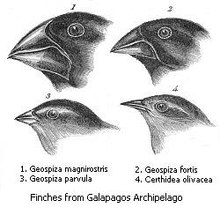Genetic variation
| Part of a series on |
| Evolutionary biology |
|---|
 |
|



Genetic variation is the difference in DNA among individuals[2] or the differences between populations.[3] There are multiple sources of genetic variation, including mutation and genetic recombination.[4] Mutations are the ultimate sources of genetic variation, but other mechanisms such as sexual reproduction and genetic drift contribute to it as well.[3]
Among individuals within a population[]
Genetic variation can be identified at many levels. It is possible to identify genetic variation from observations of phenotypic variation in either quantitative traits (traits that vary continuously and are coded for by many genes (e.g., leg length in dogs)) or discrete traits (traits that fall into discrete categories and are coded for by one or a few genes (e.g., white, pink, red petal color in certain flowers)).[5]
Genetic variation can also be identified by examining variation at the level of enzymes using the process of protein electrophoresis.[6] Polymorphic genes have more than one allele at each locus. Half of the genes that code for enzymes in insects and plants may be polymorphic, whereas polymorphisms are less common among vertebrates.[5]
Ultimately, genetic variation is caused by variation in the order of bases in the nucleotides in genes. New technology now allows scientists to directly sequence DNA which has identified even more genetic variation than was previously detected by protein electrophoresis. Examination of DNA has shown genetic variation in both coding regions and in the non-coding intron region of genes.[5]
Genetic variation will result in phenotypic variation if variation in the order of nucleotides in the DNA sequence results in a difference in the order of amino acids in proteins coded by that DNA sequence, and if the resultant differences in amino acid sequence influence the shape, and thus the function of the enzyme.[7]
Between populations[]
This section does not cite any sources. (August 2021) |
Geographic variation means genetic differences in populations from different locations. This is caused by natural selection or genetic drift.
Measurement[]
Genetic variation within a population is commonly measured as the percentage of polymorphic gene loci or the percentage of gene loci in heterozygous individuals.
Sources[]

Random mutations are the ultimate source of genetic variation. Mutations are likely to be rare and most mutations are neutral or deleterious, but in some instances, the new alleles can be favored by natural selection.
Polyploidy is an example of chromosomal mutation. Polyploidy is a condition wherein organisms have three or more sets of genetic variation (3n or more).
Crossing over (genetic recombination) and random segregation during meiosis can result in the production of new alleles or new combinations of alleles. Furthermore, random fertilization also contributes to variation.
Variation and recombination can be facilitated by transposable genetic elements, endogenous retroviruses, LINEs, SINEs, etc.
For a given genome of a multicellular organism, genetic variation may be acquired in somatic cells or inherited through the germline.
Forms[]
Genetic variation can be divided into different forms according to the size and type of genomic variation underpinning genetic change. Small-scale sequence variation (<1 kilobase, kb) includes base-pair substitution and indels.[8] Large-scale structural variation (>1 kb) can be either copy number variation (loss or gain), or chromosomal rearrangement (translocation, inversion, or Segmental acquired uniparental disomy).[8] Genetic variation and recombination by transposable elements and endogenous retroviruses sometimes is supplemented by a variety of persistent viruses and their defectives which generate genetic novelty in host genomes. Numerical variation in whole chromosomes or genomes can be either polyploidy or aneuploidy.
Maintenance in populations[]
A variety of factors maintain genetic variation in populations. Potentially harmful recessive alleles can be hidden from selection in the heterozygous individuals in populations of diploid organisms (recessive alleles are only expressed in the less common homozygous individuals). Natural selection can also maintain genetic variation in balanced polymorphisms. Balanced polymorphisms may occur when heterozygotes are favored or when selection is frequency dependent.
RNA viruses[]
A high mutation rate caused by the lack of a proofreading mechanism appears to be a major source of the genetic variation that contributes to RNA virus evolution.[9] Genetic recombination also has been shown to play a key role in generating the genetic variation that underlies RNA virus evolution.[9] Numerous RNA viruses are capable of genetic recombination when at least two viral genomes are present in the same host cell.[10] RNA recombination appears to be a major driving force in determining genome architecture and the course of viral evolution among Picornaviridae ((+)ssRNA) (e.g. poliovirus).[11] In the Retroviridae ((+)ssRNA)(e.g. HIV), damage in the RNA genome appears to be avoided during reverse transcription by strand switching, a form of genetic recombination.[12][13][14] Recombination also occurs in the Coronaviridae ((+)ssRNA) (e.g. SARS).[15] Recombination in RNA viruses appears to be an adaptation for coping with genome damage.[10] Recombination can occur infrequently between animal viruses of the same species but of divergent lineages. The resulting recombinant viruses may sometimes cause an outbreak of infection in humans.[15]
See also[]
References[]
- ^ Darwin, 1845. Journal of researches into the natural history and geology of the countries visited during the voyage of H.M.S. Beagle round the world, under the Command of Capt. Fitz Roy, R.N. 2d edition.
- ^ "What is genetic variation?". EMBL-EBI Train online. 2017-06-05. Retrieved 2019-04-03.
- ^ Jump up to: a b "Genetic Variation". Genome.gov. Retrieved 2020-09-28.
- ^ Levinson, Gene (2020). Rethinking evolution: the revolution that's hiding in plain sight. World Scientific. ISBN 9781786347268.
- ^ Jump up to: a b c "Genetic Variation Scientific Journals | Peer Reviewed Articles". www.openaccessjournals.com. Retrieved 2020-10-01.
- ^ https://www.yourgenome.org/facts/what-is-gel-electrophoresis
- ^ Pavlopoulos, GA; Oulas, A; Iacucci, E; Sifrim, A; Moreau, Y; Schneider, R; Aerts, J; Iliopoulos, I (25 July 2013). "Unraveling genomic variation from next generation sequencing data". BioData Mining. 6 (1): 13. doi:10.1186/1756-0381-6-13. PMC 3726446. PMID 23885890.
- ^ Jump up to: a b Lars Feuk, Andrew R. Carson & Stephen W. Scherer (February 2006). "Structural variation in the human genome". Nature Reviews Genetics. 7 (2): 85–97. doi:10.1038/nrg1767. PMID 16418744.
- ^ Jump up to: a b Carrasco-Hernandez R et al. Are RNA Viruses Candidate Agents for the Next Global Pandemic? A Review. ILAR J. 2017 Dec 15;58(3):343-358. doi: 10.1093/ilar/ilx026. PMID 28985316; PMCID: PMC7108571.
- ^ Jump up to: a b Barr JN, Fearns R (June 2010). "How RNA viruses maintain their genome integrity". The Journal of General Virology. 91 (Pt 6): 1373–87. doi:10.1099/vir.0.020818-0. PMID 20335491.
- ^ Muslin C, Mac Kain A, Bessaud M, Blondel B, Delpeyroux F (September 2019). "Recombination in Enteroviruses, a Multi-Step Modular Evolutionary Process". Viruses. 11 (9): 859. doi:10.3390/v11090859. PMC 6784155. PMID 31540135.
- ^ Hu WS, Temin HM (November 1990). "Retroviral recombination and reverse transcription". Science. 250 (4985): 1227–33. Bibcode:1990Sci...250.1227H. doi:10.1126/science.1700865. PMID 1700865.
- ^ Rawson JM, Nikolaitchik OA, Keele BF, Pathak VK, Hu WS (November 2018). "Recombination is required for efficient HIV-1 replication and the maintenance of viral genome integrity". Nucleic Acids Research. 46 (20): 10535–45. doi:10.1093/nar/gky910. PMC 6237782. PMID 30307534.
- ^ Bernstein H, Bernstein C, Michod RE (January 2018). "Sex in microbial pathogens". Infection, Genetics and Evolution. 57: 8–25. doi:10.1016/j.meegid.2017.10.024. PMID 29111273.
- ^ Jump up to: a b Su S, Wong G, Shi W, Liu J, Lai AC, Zhou J, et al. (June 2016). "Epidemiology, Genetic Recombination, and Pathogenesis of Coronaviruses". Trends in Microbiology. 24 (6): 490–502. doi:10.1016/j.tim.2016.03.003. PMC 7125511. PMID 27012512.
Further reading[]
- Mayr E. (1970): Populations, species, and evolution – An abridgment of Animal species and evolution. The Belknap Press of Harvard University Press, Cambridge, Massachusetts and London, England, ISBN 0-674-69013-3.
- Dobzhansky T. (1970): Genetics of the evolutionary process. Columbia, New York, ISBN 0-231-02837-7.
- McGinley, Mark; J. Emmett Duffy (ed). 2008. "Genetic variation." In: Encyclopedia of Earth. Washington, D.C.: National Council for Science and the Environment.
- "Genetic Variation" in Griffiths, A.J.F. Modern Genetic Analysis, Vol 2., p. 7
- "How is Genetic Variation Maintained in Populations" in Sadava, D. et al. Life: The Science of Biology, p. 456
- Nevo, E.; Beiles, A. "Genetic variation in nature". Scholarpedia, 6(7):8821. doi:10.4249/scholarpedia.8821
- Hedrick P. (2011): Genetics of populations. Jones & Bartlett Learning, ISBN 978-0-7637-5737-3.
- Albers P. K. and McVean G. (2018): Dating genomic variants and shared ancestry in population-scale sequencing data. bioRxiv: 416610. doi:10.1101/416610.
- Rieger R. Michaelis A., Green M. M. (1976): Glossary of genetics and cytogenetics: Classical and molecular. Springer-Verlag, Heidelberg - New York, ISBN 3-540-07668-9; ISBN 0-387-07668-9.
- Griffiths, A. J. F. (1999). An Introduction to genetic analysis. W. H. Freeman, San Francisco, ISBN 0-7167-3520-2.
- Cavalli-Sforza L. L., Bodmer W. F. (1999): The genetics of human populations. Dover, Mineola, New York, ISBN 0-486-40693-8.
External links[]
- Population genetics
